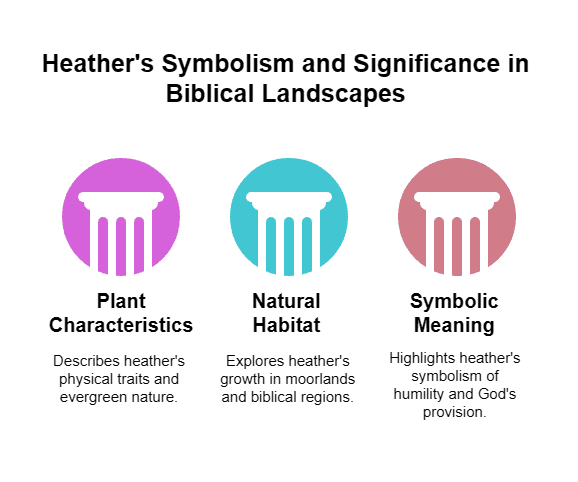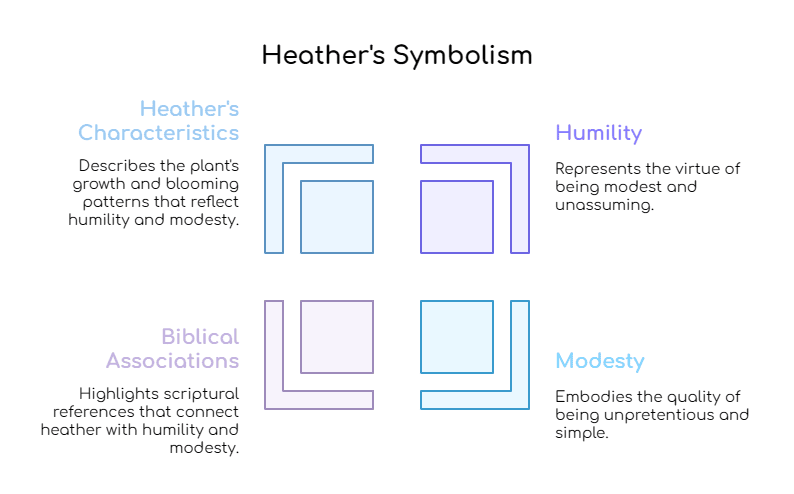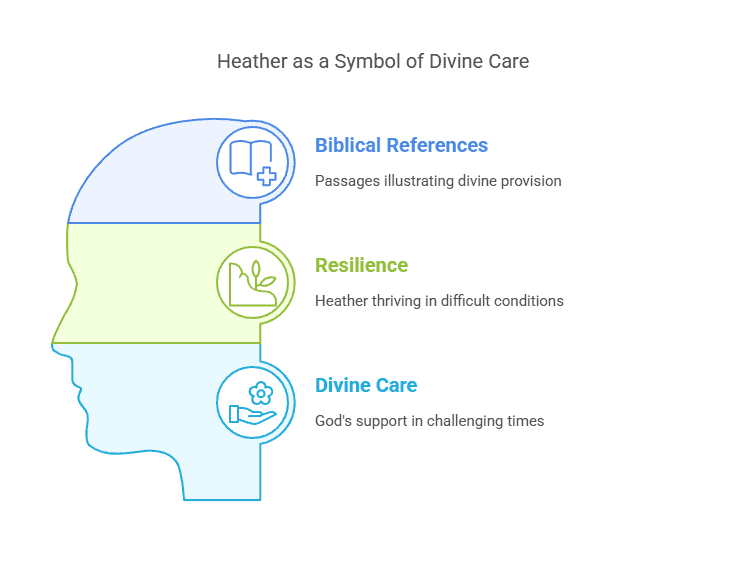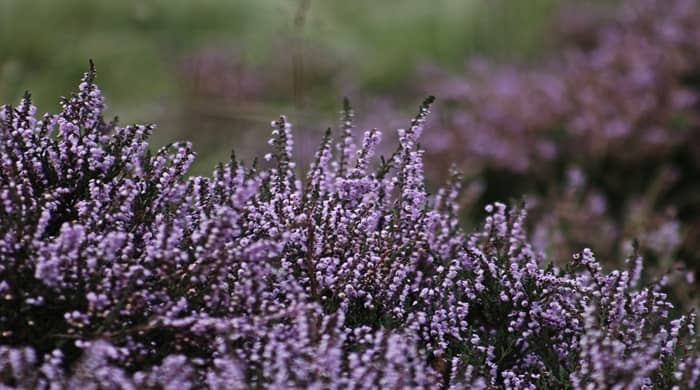Biblical symbolism is a fascinating aspect of the scriptures that adds depth and layers of meaning to the text. Throughout the Bible, various objects, animals, plants, and even numbers are imbued with symbolic significance that serves to convey powerful messages and teachings.
Symbolism in the Bible allows for a greater understanding of spiritual truths while engaging readers in a profound and thought-provoking way. From the very beginning of human history, biblical symbolism has been used to convey complex ideas and concepts that transcend mere literal interpretation.
It offers readers an opportunity to explore deeper dimensions of faith and unravel hidden truths embedded within the texts. Whether it’s through metaphors, allegories, or parables, biblical symbolism serves as a bridge between the material world and the spiritual realm.
Introducing Heather in the Bible
In this article, we delve into an intriguing subject often overlooked: heather in the Bible. While seemingly insignificant at first glance, this humble plant carries symbolic weight within certain biblical passages. Heather is known for its delicate appearance yet remarkable resilience – characteristics that resonate metaphorically with certain virtues emphasized in scripture.
Though not explicitly mentioned frequently throughout biblical texts like other well-known plants such as roses or lilies, heather plays a subtle yet meaningful role when it does make an appearance. By exploring these instances and analyzing their context within biblical narratives, we can gain insights into its symbolic implications.
So why focus on heather? The answer lies in uncovering hidden meanings behind seemingly ordinary elements found within scripture.
By studying how nature is utilized symbolically in biblical contexts, we find countless opportunities for introspection and personal growth. Heather’s presence leads us down a path where we can deepen our understanding of essential virtues such as humility, modesty, God’s provision, and care for His creation.
Overview of Heather in Biblical Context

Definition and Characteristics of Heather as a Plant
Heather, scientifically known as Calluna vulgaris, is a small evergreen shrub that belongs to the Ericaceae family. This charming plant is renowned for its delicate flowers, usually ranging from shades of pink to purple.
With its needle-like leaves and compact growth habit, heather adds an enchanting touch to landscapes across various regions. In biblical context, heather holds significant symbolism that we will explore further.
Mention of Heather’s Natural Habitat and Prevalence in Biblical Regions
Heather thrives in a variety of environments, including moorlands, grasslands, and rocky habitats. Though it may not be explicitly mentioned by name in the Bible, heather’s presence can be inferred from passages describing such landscapes.
These areas are common throughout biblical regions like ancient Israel and surrounding areas. The captivating beauty of heather would have surely caught the attention of those living during biblical times.
In regions such as the highlands of Scotland or parts of Ireland, where heather grows abundantly even today, one can easily imagine how this plant would have made an impression on ancient cultures. Its resilience in harsh conditions and vibrant colors could have easily inspired poetic descriptions or spiritual interpretations.
Furthermore, heather is known for attracting bees with its nectar-rich blossoms. Bees play a crucial role in pollination and honey production—elements that are often symbolically associated with productivity and abundance within biblical texts.
This connection highlights the potential significance attributed to heather within these ancient societies. As we delve deeper into the symbolic meaning associated with this exquisite plant within biblical contexts, we will uncover how heather serves as a reminder of humility, God’s provision, and much more.
Symbolism and Meaning of Heather in the Bible

The Language of Nature: Symbolism in Biblical Texts
Plants have always held a special place in biblical texts, serving as powerful symbols to convey deeper meanings and messages. From the grandeur of the mighty cedar trees to the delicate petals of a lily, vegetation is often used to evoke emotions and illustrate spiritual truths. In this rich tapestry of symbolism, heather emerges as a fascinating botanical symbol with its own unique significance.
The Hidden Allusions: Instances of Heather in the Bible
While heather may not be explicitly mentioned by name throughout the scriptures, its presence can be subtly perceived through allusions and references. This elusive plant appears to have captivated biblical writers, weaving its way into sacred texts with profound intent.
One such example can be found in Matthew 6:28-30, where Jesus teaches his followers about trust in God’s providence. He speaks of how God clothes “the grass of the field,” which many scholars believe refers metaphorically to heather.
The passage highlights how even though wildflowers are ephemeral and seemingly insignificant, God still provides for their beauty and sustenance. This evokes a sense that just as God cares for these humble plants, so too does He care for His people.
Another instance where heather is indirectly referenced occurs in Luke 12:27-28. Here, Jesus asks his disciples to consider how lilies grow effortlessly without labored toil or worry.
Scholars suggest that lilies mentioned here might actually refer to heather due to their similar appearance and shared symbolism. The passage encourages believers not to fret but instead trust in divine provision, drawing inspiration from heather’s tranquil existence amidst adversity.
The nuanced presence of heather within these passages demonstrates how biblical authors embraced nature’s imagery as a means to convey profound spiritual truths. By invoking the symbolism of heather, these texts emphasize the themes of trust, humility, and God’s care for His creation.
Unlocking the Symbolic Tapestry
The symbolic language of plants in biblical texts often requires a discerning eye to fully appreciate the profound messages they convey. Heather’s hidden presence within these scriptures serves as a reminder that even apparently insignificant elements of creation can carry deep spiritual meaning.
As we explore further into this topic, we will unravel more layers of heather’s significance and discover how it symbolizes virtues such as humility, resilience, and God’s loving provision in unexpected ways. So let us delve deeper into the enchanting world where flora becomes a conduit for divine wisdom.
Heather’s Symbolism as a Sign of Humility and Modesty

The Humble Beauty of Heather
When exploring the symbolism of heather in the Bible, one significant aspect that emerges is its association with humility and modesty. Throughout scripture, various verses subtly hint at these virtues by mentioning heather or drawing comparisons to its characteristics.
One example is found in Matthew 6:28-29, where Jesus speaks about the lilies of the field and how they neither toil nor spin, yet are adorned more splendidly than King Solomon. In this context, heather can be seen as representing a humble beauty that doesn’t require extravagant adornments to shine.
Passages highlighting Humility and Modesty
Although direct mentions of heather may be scarce in biblical texts, there are multiple passages that highlight humility and modesty as valued traits. For instance, Proverbs 15:33 states, “The fear of the Lord teaches wisdom; humility precedes honor.” This verse emphasizes that true wisdom comes from acknowledging one’s place before a higher power while embracing humbleness. Similarly, in Micah 6:8, we find the powerful exhortation to “act justly and to love mercy and to walk humbly with your God.” These verses exemplify how humility is regarded as an essential virtue within biblical teachings.
Aligning Heather’s Characteristics with Humility and Modesty
Heather’s own characteristics align remarkably well with the qualities of humility and modesty mentioned in scripture. Firstly, heather plants typically grow close to the ground in small clusters or low-lying shrubs.
This humble growth pattern mirrors the idea of staying grounded rather than seeking attention or prominence. Additionally, heather blooms delicately in an array of soft colors like pink, purple, or white—colors that exude a sense of subtlety and understated beauty.
This unpretentious blossoming perfectly embodies the concept of modesty, suggesting that true beauty lies not in showiness but in simplicity. Just as heather doesn’t strive for attention, so should individuals strive for humility and modesty in their actions.
Heather’s symbolism as a sign of humility and modesty is derived from its association with biblical verses highlighting these virtues. While direct mentions of heather may be limited, its qualities align remarkably well with the concept of humility and modesty within religious teachings.
The humble beauty of heather reminds us that true glory does not lie in external adornments but rather in remaining grounded and embracing simplicity. By reflecting on these symbolic connections, individuals can find inspiration to cultivate humility and modesty within their own lives, thereby embodying the virtues emphasized throughout scripture.
Heather’s Symbolism as a Reminder of God’s Provision and Care

The Bountiful Parallels between Heather and God’s Provision
In the Bible, there are numerous instances where the provision and care of God are compared to heather. This comparison is not accidental; rather, it serves as a powerful reminder of how God meets our needs even in challenging circumstances. When we look at heather, we see a plant that thrives in seemingly inhospitable conditions.
Its resilience and ability to bloom in rocky terrains or barren landscapes illustrate God’s care for His creation. Just as heather finds sustenance in harsh environments, so too does God provide for us, supplying our needs even when it seems impossible.
Illustrative Passages Highlighting Heather’s Symbolic Connection
One notable biblical passage that symbolically connects heather with divine provision can be found in Matthew 6:28-30. In this passage known as the “Sermon on the Mount,” Jesus references lilies of the field, which scholars believe could also refer to wildflowers such as heather. Jesus reminds his listeners about how these flowers neither toil nor spin, yet they are clothed with beauty surpassing Solomon’s glory.
This analogy emphasizes how if God clothes something as delicate as wildflowers with such splendor, He will undoubtedly provide for His people. Another insightful passage that echoes this connection is found in Isaiah 41:19-20, where the prophet speaks of God’s promise: “I will put in the wilderness the cedar, the acacia, the myrtle, and the olive…that they may see and know…that I have done it.” Here again, we witness how even plants like cedar and myrtle (which grow well outside harsh landscapes) are used metaphorically to demonstrate God’s providential provisions amidst challenging circumstances.
Thriving in Harsh Conditions: A Testament to God’s Care
The resilience of heather in withstanding harsh conditions symbolizes God’s care for His creation. Just as heather thrives despite rocky terrains, we can find solace in the knowledge that God is with us during our most challenging moments. The symbolism further suggests that although life may present obstacles and difficult circumstances, God’s provision and care are always available to help us flourish.
Conclusion
When we explore the symbolism of heather in the Bible, we uncover a profound message of God’s provision and care. The comparison between heather and divine sustenance serves as a reminder that no matter how daunting our circumstances may appear, God never fails to provide for His creation.
Heather’s ability to thrive in harsh conditions symbolizes our own capacity for resilience under challenging situations. So let us take comfort in knowing that just as heather blooms amidst rugged landscapes, we too can find strength and hope through God’s unwavering care.




